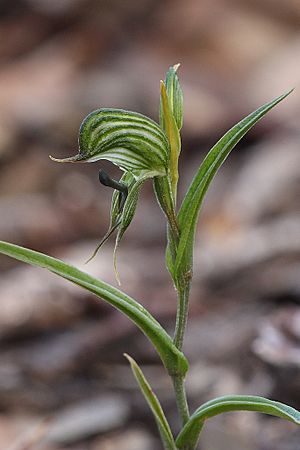Frog greenhood facts for kids
Quick facts for kids Frog greenhood |
|
|---|---|
 |
|
| Pterostylis sargentii between Williams and Narrogin | |
| Scientific classification | |
| Genus: |
Pterostylis
|
| Species: |
sargentii
|
| Synonyms | |
|
|
The Pterostylis sargentii, also known as the frog greenhood, is a special kind of plant in the orchid family. It grows only in the south-west part of Western Australia. This orchid is quite common and has unique white flowers with green or brown stripes. Its most interesting feature is a fleshy, three-part labellum (which is like a lip) that looks a bit like a frog!
If you see a frog greenhood that isn't flowering, you'll notice a group of leaves arranged in a circle, called a rosette, growing on a short stem.
Contents
What Does the Frog Greenhood Look Like?
The frog greenhood is a plant that grows from an underground tuber (like a small potato). It's a perennial plant, meaning it lives for more than two years, and it's deciduous, so it loses its leaves at certain times.
Non-flowering plants have a rosette of three to six leaves. These leaves are about 5 to 18 millimetres (0.2 to 0.7 inches) long and 3 to 8 millimetres (0.1 to 0.3 inches) wide.
When the plant is ready to flower, it grows a stem that is 50 to 200 millimetres (2 to 8 inches) tall. This stem has three to ten leaves on it, which are 8 to 30 millimetres (0.3 to 1.2 inches) long and 2 to 4 millimetres (0.08 to 0.2 inches) wide.
Up to six white flowers with green or brown stripes grow on this stem. Each flower is about 15 to 25 millimetres (0.6 to 1 inch) long and 5 to 7 millimetres (0.2 to 0.3 inches) wide.
The top part of the flower, called the "galea," looks like a hood. It's formed by the dorsal sepal (a leaf-like part) and the petals. The dorsal sepal has a tiny thread-like tip, about 2 to 3 millimetres (0.08 to 0.1 inches) long.
The lower sepals point downwards and are joined together for about half their length. Then they suddenly become very narrow tips, about 4 to 6 millimetres (0.16 to 0.24 inches) long.
The labellum (the "lip" of the orchid) is dark brown and about 4 to 5 millimetres (0.16 to 0.20 inches) long and 2 millimetres (0.08 inches) wide. It has three lobes, and the ones on the side have a large, horn-like appendage (a growth).
These orchids usually bloom between July and October.
How the Frog Greenhood Got Its Name
The frog greenhood was first officially described in 1905 by a British educator named Cecil Rollo Payton Andrews. He published his description in a scientific journal called Journal of the West Australian Natural History Society.
The second part of its scientific name, sargentii, was chosen to honor Oswald Sargent. He was a pharmacist from Western Australia who collected the very first sample of this plant that was used for its scientific description. This first sample is called the "type specimen."
Where Does the Frog Greenhood Grow?
You can find the frog greenhood in many different places across the south-west of Western Australia. It's especially common in the areas between Mullewa and Grass Patch.
Is the Frog Greenhood Protected?
The Western Australian Government's Department of Parks and Wildlife has looked at the frog greenhood. They have classified it as "not threatened." This means that currently, there are enough of these plants, and they are not considered to be in danger of disappearing.

